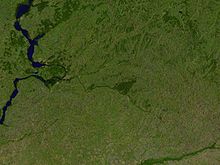53°07′N 50°04′E / 53.117°N 50.067°E / 53.117; 50.067

The Samara Bend (Samarskaya Luka; Russian: Самарская Лука) is a large hairpin bend of the middle Volga River to the east where it meets the Samara River. It is situated in the Samara region of Russia.
As the Volga enters its middle course it reaches the Zhiguli Mountains. The Samara Bend is formed as the river circles these hills. The Samara Bend National Park, one of the first in the USSR, was established in 1984. Some pockets of the park's territory are among the northernmost points of the Great European Steppe.
The Samara Bend is noted for a remarkable succession of archaeological cultures from 7000 BC to 4000 BC. These sites have revealed Europe's earliest pottery (Elshanka culture), the world's oldest horse burial and signs of horse worship (the Syezzheye cemetery of Samara culture), and the earliest kurgans associated with Proto-Indo-Europeans (e.g., Krivoluchye assigned to Khvalynsk culture).
See also
References
- "Samara Bend". Russian Geographical Society. 10 May 2011. Retrieved 10 December 2013.
- Anthony, David W. (August 15, 2010). The Horse, the Wheel, and Language: How Bronze-Age Riders from the Eurasian Steppes Shaped the Modern World. Princeton University Press. ISBN 9780691148182.
- Kuzʹmina, Elena Efimovna (2007). The Origin of the Indo-Iranians. BRILL. ISBN 9789004160545.
- Marija Gimbutas. The Prehistory of Eastern Europe. Part 1 (1956). P. 55.